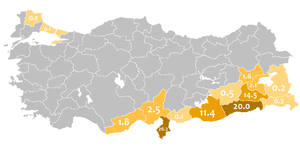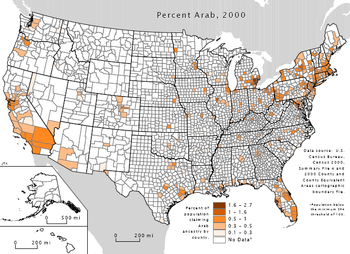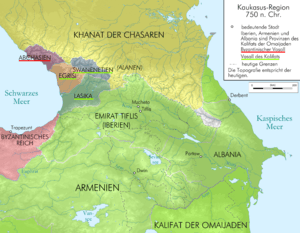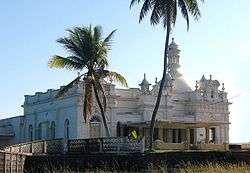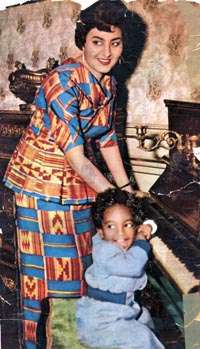Arab diaspora
| Total population | |
|---|---|
| According to the International Organization for Migration, there are 13 million Arab migrants, of whom 5.8 million reside in Arab countries. | |
| Regions with significant populations | |
| 12,000,000[1][2][lower-alpha 1] | |
| 4,189,000 (mostly from the Maghreb)[4] | |
| 15,000,000[5] | |
| 5,000,000[6][7][8][9][10] | |
| 4,500,000[11] | |
| 3,700,000[12] | |
| 1,600,000[13] | |
| 1,500,000[14] | |
| 1,500,000[15] | |
| 1,500,000[16][17] | |
| 1,400,000[18] | |
| 1,473,000[19] | |
| 1,350,000[20][21] | |
| 1,155,390[22][23] | |
| 800,000[24][25][26][27] | |
| 750,925[28] | |
| 500,000[29] | |
| 500,000[30] | |
| 250,000 [31] | |
| 275,000 [32][33] | |
| 265,000[34] | |
| 800,000 (600,000 from Morocco) | |
| 425,000 | |
| 121,000 | |
| 480,000–613,800[35] | |
| Languages | |
| Arabic (mother tongue), French, Italian, Spanish, English, Portuguese, Hebrew, Japanese, German, Turkish and other languages among others | |
| Religion | |
| Predominantly Christianity in the Americas, Islam in Europe, but also Druze and irreligion, among others | |
| Related ethnic groups | |
Arab diaspora refers to descendants of the Arab immigrants who, voluntarily or as refugees, emigrated from their native lands to non-Arab countries, primarily in South America, Europe, North America, and parts of South Asia, Southeast Asia, the Caribbean, and West Africa.
According to the International Organization for Migration, there are 13 million,[36] of which 5.8 million reside in Arab countries. Arab expatriates contribute to the circulation of financial and human capital in the region and thus significantly promote regional development. In 2009 Arab countries received a total of 35.1 billion USD in remittance in-flows and remittances sent to Jordan, Egypt and Lebanon from other Arab countries are 40 to 190 per cent higher than trade revenues between these and other Arab countries.[37] Large numbers of Arabs migrated to West Africa, particularly Côte d'Ivoire,[38] Senegal,[39] Sierra Leone, Liberia, and Nigeria.[40] Since the end of the civil war in 2002, Lebanese traders have become re-established in Sierra Leone.
Arab traders have long operated in Southeast Asia, trading in spices, timber and textiles. But an important trading minority in the region that goes largely unrecognised comprises the local descendants of Arabs. Most of the prominent Indonesians, Malaysians, and Singaporeans of Arab descent have their origins in the southern part of the Arabian Peninsula, especially the coastal Hadhramaut region of Yemen. They are the Hadramis. As many as fifteen million Indonesians are mainly of Hadrami descent.[41][42]
According to Saudi Aramco World, the largest concentration of Arabs outside the Arab World is in Brazil, which has 9 million Brazilians of Arab ancestry.[43] Of these 9 million Arabs, 6 million are of Lebanese ancestry,[44][45][46] making Brazil's population of Lebanese greater than that of Lebanon itself. About 3 million Brazilians of Arab descent are Syrians. Most others Brazilians of Arab descent are mainly from Palestine, Jordan, Egypt and Saudi-Arabia. Other large Arab communities includes Argentina, Venezuela,[47] Colombia, Mexico and Chile. Palestinians cluster in Chile and Central America, particularly El Salvador, and Honduras.[48] The Palestinian community in Chile[49][50] is the fourth largest in the world after those in Israel, Lebanon, and Jordan. Arab Haitians (a large number of whom live in the capital) are more often than not, concentrated in financial areas where the majority of them establish businesses. In the United States, there are around 3.5 million people of Arab ancestry.[51]
Distribution
Please note this is about the text of this Wikipedia article; it should not be taken to reflect on the subject of this article.
Do not restore or edit the blanked content on this page until the issue is resolved by an administrator, copyright clerk or OTRS agent.
If you have just labeled this page as a potential copyright issue, please follow the instructions for filing at the bottom of the box.

The previous content of this page or section has been identified as posing a potential copyright issue, as a copy or modification of the text from the source(s) below, and is now listed on Wikipedia:Copyright problems :
Unless the copyright status of the text on this page is clarified, the problematic text or the entire page may be deleted one week after the time of its listing.
Temporarily, the original posting is still accessible for viewing in the page history.
- You must permit the use of your material under the terms of the Creative Commons Attribution-Sharealike 3.0 Unported License (CC-BY-SA) and the GNU Free Documentation License (GFDL) (unversioned, with no invariant sections, front-cover texts, or back-cover texts).
- Explain your intent to license the content on this article's discussion page
- To confirm your permission, you can either display a notice to this effect at the site of original publication or send an e-mail from an address associated with the original publication to permissions-en

- Note that articles on Wikipedia must be written from a neutral point of view and must be verifiable in published third-party sources; consider whether, copyright issues aside, your text is appropriate for inclusion in Wikipedia.
Your rewrite should be placed on this page, where it will be available for an administrator or clerk to review it at the end of the listing period. Follow this link to create the temporary subpage.
- Simply modifying copyrighted text is not sufficient to avoid copyright infringement—if the original copyright violation cannot be cleanly removed or the article reverted to a prior version, it is best to write the article from scratch. (See Wikipedia:Close paraphrasing.)
- For license compliance, any content used from the original article must be properly attributed; if you use content from the original, please leave a note at the top of your rewrite saying as much. You may duplicate non-infringing text that you had contributed yourself.
- It is always a good idea, if rewriting, to identify the point where the copyrighted content was imported to Wikipedia and to check to make sure that the contributor did not add content imported from other sources. When closing investigations, clerks and administrators may find other copyright problems than the one identified. If this material is in the proposed rewrite and cannot be easily removed, the rewrite may not be usable.
- Posting copyrighted material without the express permission of the copyright holder is unlawful and against Wikipedia policy.
- If you have express permission, this must be verified either by explicit release at the source or by e-mail or letter to the Wikimedia Foundation. See Wikipedia:Declaration of consent for all enquiries.
- Policy requires that we block those who repeatedly post copyrighted material without express permission.
If you have tagged the article for investigation, please complete the following steps:
- Add the following to the bottom of Wikipedia:Copyright_problems/2018 August 24
* {{subst:article-cv|:Arab diaspora}} from numerous urls. ~~~~ - Place this notice on the talk page of the contributor of the copyrighted material:
{{subst:Nothanks-web|pg=Arab diaspora|url=numerous urls}} ~~~~ - To blank a section instead of an entire article, add the template to the beginning of the section and </div> at the end of the portion you intend to blank.
Notable people
Prominent members of the Arab diaspora include:
Business
- Mohamed Al-Fayed (Egyptian origin), businessman, former owner of London's Harrods and the Ritz Palace in Paris
- Mohed Altrad (Syrian origin), French billionaire businessman
- André Apaid (Lebanese origin), high-profile Haitian businessman
- Nadhmi Auchi (Iraqi origin), businessman, founder and Chairman of General Mediterranean Holdings
- Miguel Facussé Barjum (Palestinian origin), Honduran businessman and landowner
- Mohamed A. El-Erian (Egyptian origin), Egyptian-French-American businessman and asset manager; former CEO of PIMCO and current chief economic adviser at Allianz
- Charles Elachi (Lebanese origin), Director of the Jet Propulsion Laboratory (JPL)
- Carlos Ghosn (Lebanese origin), Brazilian-French-Lebanese businessman, CEO of Renault-Nissan
- Mohamed Hadid (Palestinian origin), Jordanian-American luxury real estate developer and businessman
- Nicolas Hayek (Lebanese origin), Swiss-Lebanese American entrepreneur, co-founder, CEO and Chairman of the Board of the Swatch Group
- Carlos Slim Helú (Lebanese origin), Mexican businessman; listed by Forbes as the richest man in the world
- Antoine Izméry (Palestinian origin), Former wealthy Haitian businessman and pro-democracy activist
- Steve Jobs (Syrian origin), American businessman and inventor; Apple Inc co-founder, chairman and CEO
- George J. Maloof, Sr. (Lebanese origin), American businessman, owner of the Houston Rockets
- Fredy Nasser (Palestinian origin), Honduran businessman
- Awadh Saleh Sherman (Yemeni origin), Kenyan businessman
Fashion, beauty
- Azzedine Alaia (Tunisian origin), fashion designer
- Constanza Baez (Lebanese origin), Miss Ecuador 2013 winner and 2nd runner-up at Miss Universe 2013
- Valerie Domínguez (Lebanese origin), Miss Colombia 2005 winner and Top 10 finalist at Miss Universe 2006
- Rima Fakih (Lebanese origin), Miss USA 2010 winner from Michigan
- Gigi Hadid (Palestinian origin), American model
- Lisa Hanna (Lebanese origin), Miss World 1993 winner from Jamaica
- Sabrina Houssami (Lebanese origin), Miss World 2006 (2nd runner-up) from Australia
- Jessica Kahawaty (Lebanese origin), Miss World 2012 (2nd runner-up) from Australia
- Yves Saint Laurent (Algerian origin), fashion designer
- Hedi Slimane (Tunisian origin), fashion designer and former creative director of Yves Saint-Laurent
- Paulina Vega (Lebanese origin), Miss Colombia 2013 Miss Universe 2014
- Paola Turbay (Lebanese origin), Miss Universe 1992 (1st runner-up) from Colombia
Film, television
- Hiba Abouk (Libian and Tunisian origin), Spanish actress
- Tige Andrews (Syrian origin), an American character actor
- Sofia Boutella (Algerian origin), American actress, dancer
- Abdel Raouf Dafri (Algerian origin), award-winning French director
- Salma Hayek (Lebanese origin), Mexican actress
- Bader Ben Hirsi (Yemeni origin), award-winning British-Yemeni director
- Abdellatif Kechiche (Tunisian origin), French film director, actor and screenwriter; Palme d'Or laureate
- Nawell Madani (Algerian origin), Belgian humorist, presenter and producer
- Rami Malek (Egyptian origin), American actor
- Elyas M'Barek (Tunisian origin), Austrian actor born in Germany
- Kad Merad (Algerian origin), French comedian, actor, and filmmaker
- Tahar Rahim (Algerian origin), award-winning French actor
- Andy Serkis (Iraqi origin), English actor, director, and author
- Omar Sharif (Egyptian origin), award-winning international actor
Literature / theatre
- Kaouther Adimi, Algerian writer
- William Peter Blatty (Lebanese origin), American writer
- Assia Djebar, Algerian writer
- Kahlil Gibran (Lebanese origin), American poet, writer, artist
- Amin Maalouf (Lebanese origin), French author
- David Malouf (Lebanese origin), Australian writer
- Wajdi Mouawad (Lebanese origin), Canadian writer, actor and director
Media and intellectuals
- Magdi Allam (Egyptian origin), Italian journalist
- Khadija Benguenna (Algerian origin), Arab TV personality
- Hala Gorani (Syrian origin), journalist and anchor of CNN's International Desk
- Casey Kasem (Lebanese origin), American radio personality.
- Djamel Eddine Laouisset (Algerian origin), Canadian intellectual
- Tariq Ramadan (Egyptian origin), Swiss intellectual
- Edward Saïd (Palestinian origin), US intellectual
- Léa Salamé (Lebanese origin), French journalist and political commentator
Music
- Adel Tawil (Egyptian / Tunisin origin), German singer, songwriter and producer
- Ali B (Moroccan origin), Dutch rapper
- Bushido (Tunisian origin), German rapper
- DJ Khaled (Palestinian origin), American DJ
- Eric Saade (Palestinian Lebanese origin), Swedish singer
- Fady Maalouf (Lebanese origin), German singer
- Fredwreck (Palestinian origin), American record producer
- Ghali (Tunisian origin), Italian singer
- Ibrahim Maalouf (Lebanese origin), French saxophonist
- Indila (Algerian origin), French singer
- Kareem Salama (Egyptian origin), American country singer
- Karl Wolf (Lebanese origin), Canadian pop star
- La Fouine (Moroccan origin), French rapper
- L'Algérino (Algerian origin), French rapper
- Lowkey (Iraqi origin), British rapper and political activist
- Maher Zain (Lebanese origin), Swedish singer
- Malika Ayane (Moroccan origin), Italian rapper
- Massari (Lebanese origin), Canadian singer
- Master Sina (Tunisian origin), Italian rapper
- Nasri Tony Atweh (Palestinian origin), Canadian lead singer of Magic!
- Natasja Saad (Sudanese origin), Danish rapper and reggae singer
- Rami Yacoub (Palestinian origin), Swedish record producer
- RedOne (Moroccan origin), Swedish record producer
- Samy Deluxe (Sudanese origin), German rapper
- Salem Al Fakir (Syrian origin), Swedish singer
- Sarbel (Lebanese origin), Greek singer
- Shakira (Lebanese origin), Colombian singer
- Tarak Ben Ammar (Tunisian origin), international movie producer and distributor
- Tunisiano (Tunisian origin), French rapper
- Zaho (Algerian origin), Canadian singer
Politics
- Ali Alatas (Yemeni origin), former Indonesian Foreign Minister
- Geraldo Alckmin (Lebanese origin), politician, Governor of São Paulo state
- Khadija Arib (Moroccan origin), politician, Speaker of the House of Representatives (Netherlands)
- Jacobo Majluta Azar (Lebanese origin), former President of Dominican Republic
- Najib Balala (Yemeni origin), member of parliament in Kenya
- Yamina Benguigui (Algerian origin), French socialist politician
- Mohamed Bennouna (Moroccan origin), Diplomat, Jurist and Judge of the International Court of Justice in The Hague since 2006
- Salvador Jorge Blanco (Syrian origin), former President of Dominican Republic
- Abdalá Bucaram (Lebanese origin), former President of Ecuador
- Alberto Dahik (Lebanese origin), former Vice President of Ecuador
- Mitch Daniels (Syrian origin), Governor of Indiana
- Rachida Dati (Moroccan-Algerian origin), former French Minister of Justice, current Member of the European Parliament and Mayor of the 7th arrondissement of Paris
- Tareck El Aissami (father is Syrian Druze and mother is Lebanese), Vice President of Venezuela since January 2017
- Myriam El Khomri (Moroccan origin), French Minister of Labor
- Carlos Roberto Flores Facussé (Palestinian origin), former President of Honduras
- Schafik Handal (Palestinian origin), Salvadoran born FMLN leader
- Gilberto Kassab (Lebanese origin), former mayor of São Paulo
- Paulo Maluf (Lebanese origin), politician, former mayor of São Paulo city and former governor of São Paulo state in Brazil
- Carlos Menem (Syrian origin), former President of Argentina
- Arnaud Montebourg (Algerian origin), politician, former French Minister of the Economy, and candidate for the Socialist Party's presidential nomination
- Said Musa (Palestinian origin), former Prime Minister of Belize
- Ralph Nader (Lebanese origin), 2004 US presidential candidate, activist for consumer rights
- Antonio Saca (Palestinian origin), former President of El Salvador
- Edward Seaga (Lebanese origin), former Prime Minister of Jamaica
- Donna Shalala (Lebanese origin), former American Secretary of Health and Human Services
- Michel Temer (Lebanese origin), politician, 37th President of Brazil
- Najat Vallaud-Belkacem (Moroccan origin), French Minister of Education, Higher Education, and Research
Sciences
- Michael E. DeBakey (Lebanese origin), American cardiac surgeon
- Zaha Hadid (Iraqi origin), British architect
- Elias Zerhouni (Algerian origin), American National Institutes of Health Director
Sports
- Justin Abdelkader (Jordanian origin), American ice hockey player
- Brahim Asloum (Algerian origin), French professional boxer, Olympic winner
- Hatem Ben Arfa (Tunisian origin), French professional football player of Paris Saint-Germain F.C.
- Wissam Ben Yedder (Tunisian origin), French professional football player of Sevilla FC
- Migidio Bourifa (Moroccan origin), Italian long-distance runner
- Robert Farah (Lebanese origin), Colombian tennis player
- Naseem Hamed (Yemeni origin), also known as Prince Naseem, English professional boxer
- Nazem Kadri (Lebanese origin), Canadian ice hockey player
- Sami Khedira (Tunisian origin), midfielder in the German national team
- Mahiedine Mekhissi (Algerian origin), French runner, International winner
- Brandon Saad (Syrian origin), American ice hockey player
- Mário Zagallo (Lebanese origin), Brazilian football coach and former player
See also
- Algerian British
- Arab Americans
- Arab Argentines
- Arab Australians
- Arab Brazilians
- Arab Canadians
- Arab Chileans
- Arab diaspora in Colombia
- Arab Haitians
- Arab Indonesians
- Arab Mexicans
- Arab Singaporeans
- Arab Venezuelans
- Arabs in Austria
- Arabs in Bulgaria
- Arabs in Europe
- Arabs in France
- Arabs in Germany
- Arabs in Greece
- Arabs in India
- Arabs in Italy
- Arabs in the Netherlands
- Arabs in Pakistan
- Arabs in the Republic of Macedonia
- Arabs in Romania
- Arabs in Serbia
- Arabs in Spain
- Arabs in Sweden
- Arabs in Switzerland
- Arabs in Turkey
- Arma people (Saharan Arab and Spanish)
- British Arabs
- British Iraqis
- Chaush (Yemenis in South India)
- Egyptians in the United Kingdom
- Emirati diaspora
- Hadhrami diaspora
- History of Arabs in Afghanistan
- Iranian Arabs
- Iraqi Biradari (Iraqis residing in India and Pakistan)
- Iraqi diaspora
- Lebanese Americans
- Lebanese Argentines
- Lebanese Australians
- Lebanese Brazilians
- Lebanese Canadians
- Lebanese diaspora
- Lebanese people in Ecuador
- List of Arab Americans
- Magyarab people (Egyptian Arab and Hungarian)
- Palestinian diaspora
- Refugees of Iraq
- Sri Lankan Moors
- Syrian Americans
- Yemeni Americans
- Yemenis in the United Kingdom
References
Notes
- ↑ The Brazilian and Lebanese governments claim 7 million Lebanese, with 4 million Syrians. A 2008 study done by IGBE covering the states of Amazonas, Paraíba, São Paolo, Rio Grande de Sol, Mato Grosso, and Disitro Federal showed that 0.9% or 2 million white Brazilians claimed any Middle Eastern ancestry[3]
Citations
- ↑ Brazil - Brasil - BRAZZIL - News from Brazil - Arabs: They are 200 Million in Brazil - Brazilian Immigration - September 2004
- ↑ "Saudi Aramco World :The Arabs of Brazil". archive.aramcoworld.com.
- ↑ http://biblioteca.ibge.gov.br/visualizacao/livros/liv63405.pdf
- 1 2 By (29 January 2008). "French-Arabs battle stereotypes - Entertainment News, French Cinema, Media". Variety. Retrieved 22 August 2010.
- ↑ "Hadramaut dan Para Kapiten Arab". 20 August 2009.
- ↑ (UNHCR), United Nations High Commissioner for Refugees. "UNHCR Syria Regional Refugee Response". UNHCR Syria Regional Refugee Response.
- 1 2 Kaya, Ibrahim (2009). "The Iraqi Refugee Crisis and Turkey: a Legal Outlook". cadmus.eui.eu. Retrieved 25 April 2017.
- ↑ "The Impact of Syrian Refugees on Turkey". www.washingtoninstitute.org.
- ↑ "Turkey's demographic challenge". www.aljazeera.com.
- 1 2 "UNHCR Syria Regional Refugee Response/ Turkey". UNHCR. 31 December 2015. Retrieved 17 January 2016.
- 1 2 "Inmigración sirio-libanesa en Argentina" (in Spanish). Fearab.org.ar. Archived from the original on 20 June 2010. Retrieved 13 April 2010.
- ↑
- 1 2 3 "Abdel el-Zabayar: From Parliament to the Frontlines". The Daily Beast.
- 1 2 "Las mil y una historias" (in Spanish). semana.com. 2004. There is an estimated population of 1,500,000 Arabs in Colombia.
- ↑ "Iran". Archived from the original on 3 February 2012. Retrieved 3 August 2013.
- ↑ "Arabs Making Their Mark in Latin America: Generations of Immigrants in Colombia, Venezuela and Mexico | Al Jadid Magazine". www.aljadid.com.
- 1 2 Ben Cahoon. "World Statesmen.org". World Statesmen.org. Retrieved 17 September 2011.
- ↑ "Cittadini Stranieri in Italia - 2016".
- ↑ "Chad". Archived from the original on 24 April 2013. Retrieved 3 August 2013.
- 1 2 "Los musulmanes en España superan los 1,8 millones". www.europapress.es (in Spanish). 30 March 2015. Retrieved 25 April 2017.
- 1 2 Redaction (9 October 2012). "La cifra de musulmanes en España alcanza los 1,6 millones, de los que casi un tercio viven en Cataluña". www.alertadigital.com (in Spanish). Retrieved 25 April 2017.
- ↑ "Anzahl der Ausländer in Deutschland nach Herkunftsland in den Jahren 2015 und 2016". statista (in German).
- ↑ "Bevölkerung und Erwerbstätigkeit" (PDF). Statistisches Bundesamt (in German). 20 June 2017. Retrieved 11 March 2018.
- ↑ (in Spanish) En Chile viven unas 700.000 personas de origen árabe y de ellas 500.000 son descendientes de emigrantes palestinos que llegaron a comienzos del siglo pasado y que constituyen la comunidad de ese origen más grande fuera del mundo árabe. Archived 18 March 2012 at the Wayback Machine.
- 1 2 "Arabs In The Andes? Chile, The Unlikely Long-Term Home Of A Large Palestinian Community". International Business Times. 31 October 2013.
- 1 2 "Chile: Palestinian refugees arrive to warm welcome". Adnkronos.com. 7 April 2003. Retrieved 17 September 2011.
- 1 2 "500,000 descendientes de primera y segunda generación de palestinos en Chile". Laventana.casa.cult.cu. Archived from the original on 22 July 2009. Retrieved 17 September 2011.
- ↑ "Canadian Arab Institute :: 750,925 Canadians Hail from Arab Lands". www.canadianarabinstitute.org.
- ↑ Anthony McRoy. "The British Arab". National Association of British Arabs. Retrieved 17 April 2012.
- ↑ "australianarab.org/about-us". Archived from the original on 30 October 2016.
- ↑ "revistas.ucm.es/index.php/ANQE/article/viewFile/ANQE9797110057A/3864". Missing or empty
|url=(help) - ↑ "The Arabs of Honduras". Saudi Aramco World. Retrieved 8 April 2014.
- 1 2 "The Arabs of Honduras". Saudiaramcoworld.com. 27 June 1936. Retrieved 17 September 2011.
- ↑ "Statistics Japan". nipponislamcentoru. 2013. Retrieved 11 February 2016.
- ↑ "Dutch media perceived as much more biased than Arabic media – Media & Citizenship Report conducted by University of Utrecht" (PDF), Utrecht University, 10 September 2010, retrieved 29 November 2010
- ↑ "Mundo Arabe". mundoarabe.org.
- ↑ "Intra-Regional Labour Mobility in the Arab World" (PDF). International Organization for Migration (IOM) Cairo. Archived from the original (PDF) on 30 April 2011.
- ↑ "Ivory Coast - The Levantine Community". Countrystudies.us. Retrieved 17 September 2011.
- 1 2 Lebanese Immigrants Boost West African Commerce, By Naomi Schwarz, voanews.com, 10 July 2007
- 1 2 Lebanese man shot dead in Nigeria, BBC News
- ↑ Talib, Ameen Ali (November 1995). "Hadramis in Singapore". The British-Yemeni Society. Archived from the original on 26 September 2011. Retrieved 17 September 2011.
- ↑ The world's successful diasporas, World Business
- 1 2 "The Arabs of Brazil". Saudi Aramco World. Retrieved 17 September 2011.
- ↑ "Sleiman meets Brazilian counterpart, Lebanese community". The Daily Star. 23 April 2010.
- ↑ "O Líbano: Geografia" [Lebanon: Geography] (in Portuguese). Lebanese Embassy in Brazil. 1996. Archived from the original on 12 November 2010.
- ↑ "Estadão de Hoje". Estadao.com.br. Archived from the original on 1 January 2013. Retrieved 17 September 2011.
- 1 2 Habeeb Salloum, "Arabs Making Their Mark in Latin America: Generations of Immigrants in Colombia, Venezuela and Mexico", Al Jadid, Vol. 6, no. 30 (Winter 2000).
- ↑ "The Arabs of Honduras". Saudiaramcoworld.com. 27 June 1936. Retrieved 17 September 2011.
- ↑ "Chile: Palestinian refugees arrive to warm welcome". Adnkronos.com. 7 April 2003. Retrieved 17 September 2011.
- ↑ "500,000 descendientes de primera y segunda generación de palestinos en Chile". Laventana.casa.cult.cu. Archived from the original on 22 July 2009. Retrieved 17 September 2011.
- ↑ "The Arab American Institute". Aaiusa.org. Archived from the original on 3 April 2010. Retrieved 17 September 2011.
- ↑ "¿Cuántos musulmanes hay en España? Estudio demográfico orientativo sobre la población musulmana en España". islamhoy.com (in Spanish). 4 December 2013. Archived from the original on 9 June 2013. Retrieved 25 April 2017.
- ↑ Medina, Miguel Ángel (10 February 2014). "Los musulmanes son el 3,6% de la población en España (1,7 millones)". blogs.elpais.com (in Spanish). Planeta Futuro. Retrieved 25 April 2017.
- ↑ "spanish property". www.villa.spain-property-costa-blanca.com. Archived from the original on 29 November 2017. Retrieved 18 December 2017.
- ↑ "Arab Influences on Spanish Language and Culture | don Quijote". donQuijote.
- ↑ "BBC - Religions - Islam: Muslim Spain (711-1492)".
- 1 2 "Arabische Christen in Deutschland Er hört und Antwortet". www.cz-herborn.de (in German). Archived from the original on 15 April 2013. Retrieved 25 April 2017.
- ↑ "REPORT ON THE 2011 CENSUS – MAY 2013 – Arabs and Arab League Population in the UK". National Association of British Arabs. Archived from the original on 8 October 2014. Retrieved 9 April 2015.
- ↑ "British Arabs". www.naba.org.uk.
- ↑ Miladi, Noureddine (August 2006). "Satellite TV News and the Arab Diaspora in Britain: Comparing Al-Jazeera, the BBC and CNN" (PDF). Journal of Ethnic and Migration Studies. 32 (6): 947–960. doi:10.1080/13691830600761552. Retrieved 30 November 2012.
- ↑ "Refugees, migrants reach 54,574 in Greece on Wednesday". Kathimerini. 19 May 2016. Retrieved 19 May 2016.
- ↑ Hannes Kniffka (June 1995). Elements of culture-contrastive linguistics. P. Lang. p. 244. ISBN 978-0-8204-2927-4.
- ↑ "Dutch media perceived as much more biased than Arabic media - Media & Citizenship Report conducted by University of Utrecht" (PDF), Utrecht University, 10 September 2010, retrieved 29 November 2010
- ↑ Intra-Regional Labour Mobility in the Arab World, Facts and Figures (PDF), International Organization for Migration, 2010, retrieved 21 July 2010
- ↑ Helen Chapin Metz, ed. Turkey: A Country Study. Washington: GPO for the Library of Congress, 1995.
- 1 2 "Turkey's demographic challenge". www.aljazeera.com. Retrieved 18 December 2016.
- ↑ "The Impact of Syrian Refugees on Turkey". www.washingtoninstitute.org. Retrieved 18 December 2016.
- ↑ "Arabs in America - Arabs in America". arabsinamerica.unc.edu.
- ↑ Brown, Heather; Guskin, Emily; Mitchell, Amy (28 November 2012). "Arab-American Population Growth". Pew Research Center's Journalism Project.
- ↑ Kayyali, Randa (2006). The Arab Americans. Greenwood Press. p. 35.
- ↑ "Steve Jobs' Father Regrets Adoption, Hasn't Met Apple Founder" http://abcnews.go.com/Technology/steve-jobs-biological-father-regrets-adoption-report/story?id=14381769
- ↑ "The Arab Community in Canada". www.statcan.gc.ca.
- ↑ "Out of MENA: Nine cities the Arab Diaspora calls home". Al Bawaba. 8 May 2015.
- 1 2 3 "Articles: The Arabs of South America". www.americanthinker.com.
- ↑ "Arab roots grow deep in Brazil's rich melting pot". Washington Times. Retrieved 17 April 2016.
- ↑ "Origem e destino dos imigrantes do Levante". ibge. Retrieved 11 April 2016.
- 1 2 Brazilian Ministry of Foreign Affaires
- ↑ "Lebanon: Geography". Embassy of Lebanon in Brazil (in Portuguese). 1996. Archived from the original on 29 May 2008.
- ↑ IBGE. IBGE: Características Étnico-Raciais da População.
- ↑ "O Líbano: Geografia" [Lebanon: Geography] (in Portuguese). Lebanese Embassy in Brazil. 1996. Archived from the original on 12 November 2010.
- ↑ "Estadão de Hoje". Estadao.com.br. Archived from the original on 1 January 2013. Retrieved 17 September 2011.
- ↑ "Sirios, turcos y libaneses" [Syrians, Turks and Lebanese] (in Spanish). oni.escuelas.edu.ar. Archived from the original on 11 December 2008.
- ↑ "Mapping the Global Muslim Population: A Report on the Size and Distribution of the World's Muslim Population" (PDF). Pew Research Center. October 2009. p. 24. Retrieved 4 November 2016.
- ↑ Barros, Carolina (23 August 2012). "Argentina's Syrians". www.buenosairesherald.com. Retrieved 4 November 2016.
- ↑ "Estimación de la mortalidad, 1985-2005" [Estimation of mortality, 1985-2005] (PDF). Postcensal Studies (in Spanish). Bogotá, Colombia: DANE. March 2010. Archived from the original (PDF) on 23 November 2007. Retrieved 29 March 2016.
- ↑ Randa Achmawi (21 July 2009). "Colombia awakens to the Arab world". Brazi-Arab News Agency. Archived from the original on 6 July 2011. Retrieved 22 September 2015.
- ↑ "Proyecciones nacionales y departamentales de población. 2006-2020" [National and departmental population projections. 2006-2020] (PDF) (in Spanish). DANE National Statistical Service, Columbia. September 2007. Archived from the original (PDF) on 23 November 2007. Retrieved 22 September 2015.
- ↑ (in Spanish) Luis Angel Arango Library: Los sirio-libaneses en Colombia Archived 25 October 2006 at the Wayback Machine. lablaa.org Accessed 30 August 2007.
- ↑ "DNA Tribes® SNP Admixture Results by Population" (PDF). dnatribes.com.
- ↑ "Archived copy" (PDF). Archived from the original (PDF) on 27 March 2009. Retrieved 17 April 2010.
- ↑ S.A., Diario La Nación - Comunicaciones Lanet. " Zalaquett pone a Chile como modelo de convivencia palestino-judía". La Nación. Archived from the original on 2 January 2017.
- ↑ Arab and Jewish immigrants in Latin America: images and realities, by Ignacio Klich, Jeff Lesser, 1998, p. 165.
- ↑ In Santiago Society, No One Cares If Your Name Is Carey or de Yrarrazaval, By ENID NEMY 14 September 1969, Sunday, Arab and Jewish immigrants in Latin America.
- 1 2 3 "From Lebanon to Haiti: A Story Going Back to the 19th Century". Retrieved 30 January 2014.
- ↑ "The Arabs to Our South: The Arab Diaspora in Latin America - Arab American Institute". www.aaiusa.org.
- ↑ "Carlos Slim Helu & family". Forbes. Retrieved 5 March 2013.
- ↑ "THE MOBILE MEXICAN MAGNATE: HOW CARLOS SLIM HELU GOT HIS START". EvanCarMichael. Archived from the original on 12 April 2015. Retrieved 12 April 2015.
- ↑ Hage, ed. by Ghassan (2002). Arab-Australians today : citizenship and belonging. Carlton South: Melbourne Univ. Press. ISBN 9780522849790.
- ↑ "The Australian Arab Association" (PDF). Gosnells WA 6990. 2 June 2003. Retrieved 20 December 2016.
- ↑ Genko, A. The Arabic Language and Caucasian Studies. USSR Academy of Sciences Publ. Moscow-Leningrad. 8–109
- 1 2 Zelkina, Anna. Arabic as a Minority Language. Walter de Gruyter, 2000; ISBN 3-11-016578-3 p. 101
- ↑ Baynes, Thomas Spencer (ed). "Transcaucasia." Encyclopædia Britannica. 1888. p. 514
- ↑ Golestan-i Iram by Abbasgulu Bakikhanov. Translated by Ziya Bunyadov. Baku: 1991, p. 21
- ↑ Seferbekov, Ruslan. Characters Персонажи традиционных религиозных представлений азербайджанцев Табасарана. Archived 16 December 2008 at the Wayback Machine.
- ↑ Stephen Adolphe Wurm et al. Atlas of languages of intercultural communication. Walter de Gruyter, 1996; p. 966
- ↑ History of Ibn Khaldun
- ↑ Arabic As a Minority Language By Jonathan Owens, pg. 184
- ↑ Muslim society in transition Javed, Arifa Kulsoom ISBN 81-7169-096-3
- ↑ Frontiers of embedded Muslim communities in India / editor, Vinod K. Jairath ISBN 9780415668880
- ↑ Muslim caste in Uttar Pradesh: (a study of culture contact) by Ansari, G. (Ghaus)
- ↑ Shahab, Alwi (21 January 1996). "Komunitas Arab Di Pekojan Dan Krukut: Dari Mayoritas Menjadi Minoritas" (in Indonesian). Archived from the original on 9 August 2008. Retrieved 19 April 2015.
- 1 2 Cribb & Kahin 2004, pp. 18–19.
- ↑ "Sri Lankan Muslims Are Low Caste Tamil Hindu Converts Not Arab Descendants". Colombo Telegraph. Retrieved 27 July 2014.
- ↑ Torsten Tschacher (2001). Islam in Tamilnadu: Varia. (Südasienwissenschaftliche Arbeitsblätter 2.) Halle: Martin-Luther-Universität Halle-Wittenberg. ISBN 3-86010-627-9. (Online versions available on the websites of the university libraries at Heidelberg and Halle: http://archiv.ub.uni-heidelberg.de/savifadok/volltexte/2009/1087/pdf/Tschacher.pdf and http://www.suedasien.uni-halle.de/SAWA/Tschacher.pdf).
- ↑ "Race in Sri Lanka What Genetic evidence tells us". Retrieved 20 July 2014.
- ↑ Papiha, S.S.; Mastana, S.S.; Jaysekara, R. (October 1996). "Genetic Variation in Sri Lanka". 68 (5): 707–737 [709]. JSTOR 41465515.
- ↑ de Munck, Victor (2005). "Islamic Orthodoxy and Sufism in Sri Lanka". Anthropos: 401–414 [403]. JSTOR 40466546.
- ↑ Mahroof, M. M. M. "Spoken Tamil Dialects Of The Muslims Of Sri Lanka: Language As Identity-Classifier". Islamic Studies. 34 (4): 407–426 [408]. JSTOR 20836916.
- ↑ Romero, Patricia W. (1997). Lamu. Markus Wiener. p. 7. ISBN 1558761063. Retrieved 25 November 2014.
- ↑ Gunnar M Ahmad Abdel Ghaffar Muhammad Chr Michelsens Institutt (2013). Sudan Divided: Continuing Conflict in a Contested State. Palgrave Macmillan. p. 90. ISBN 1137338245. Retrieved 25 November 2014.
- ↑ "Ivory Coast - The Levantine Community". Countrystudies.us. Retrieved 17 September 2011.
- ↑ African Union Summit Archived 7 March 2012 at the Wayback Machine.
- ↑ Randall, Colin (19 November 2004). "The night westerners were hunted for being white". London: The Daily Telegraph. Retrieved 26 June 2009.
- ↑ Handloff, Robert E., ed. (1988). "The Levantine Community". Ivory Coast: A Country Study. Country Studies. Washington, DC: GPO for the Library of Congress.
- ↑ Young, William C., "The Rashaayda Bedouin - Arab Pastoralists of Eastern Sudan", 1996.
- ↑ Rashaida People History, Niaz Murtaza The pillage of sustainability in Eritrea 1998, p.177
- ↑ Rasooldeen, Mohammed (15 October 2015). "Saudi Arabia — Kingdom donates SR50m for Yemeni refugees in Djibouti". www.arabnews.com. Retrieved 25 April 2017.
- ↑ "PeopleGroups.org - Djiboutian Arabs of Djibouti".
- ↑ "The World Factbook — Central Intelligence Agency". www.cia.gov. Retrieved 18 December 2016.
- ↑ "Niger's Arabs to fight expulsion". news.bbc.co.uk. 25 October 2006. Retrieved 25 April 2017.
Leaders of around 150,000 Arabs in Niger say they will fight in court moves to expel them to Chad.
- ↑ "Chad - Arabs". countrystudies.us. Retrieved 18 December 2016.
Further reading
- Niger's Arabs to fight expulsion
- Out of the Hadhramaut
- Arab Immigrants in Latin American Politics
- Descendants of Arabs thriving in S. America
- The Arrival Of The Lebanese to Jamaica
- "Arab roots grow deep in Brazil's rich melting pot", The Washington Times.
- Kusumo, Fitra Ismu, Islam en America Latina - Tomo I: "La expansión del Islam y su llegada a América Latina (Spanish Edition)", Tomo II: "Migración Árabe a América Latina y el caso de México (Spanish Edition)" , Tomo III: "El Islam hoy desde América Latina (Spanish Edition)"
External links
| Wikimedia Commons has media related to Arab diaspora. |
.jpg)

